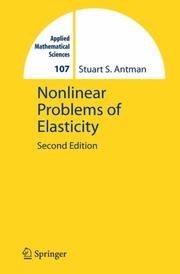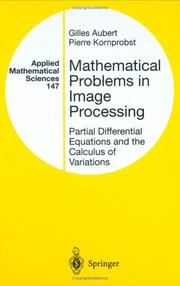| Listing 1 - 3 of 3 |
Sort by
|
Book
ISBN: 0387941991 3540941991 1475741499 1475741472 9780387941998 Year: 1995 Volume: 107 Publisher: Berlin : Springer,
Abstract | Keywords | Export | Availability | Bookmark
 Loading...
Loading...Choose an application
- Reference Manager
- EndNote
- RefWorks (Direct export to RefWorks)
Elasticity --- Nonlinear theories --- Elasticité --- Théories non linéaires --- Nonlinear theories. --- Elasticité --- Théories non linéaires

ISBN: 0387208801 9786610308309 1280308303 0387276491 Year: 2005 Publisher: New York (N.Y.) : Springer,
Abstract | Keywords | Export | Availability | Bookmark
 Loading...
Loading...Choose an application
- Reference Manager
- EndNote
- RefWorks (Direct export to RefWorks)
This second edition is an enlarged, completely updated, and extensively revised version of the authoritative first edition. It is devoted to the detailed study of illuminating specific problems of nonlinear elasticity, directed toward the scientist, engineer, and mathematician who wish to see careful treatments of precisely formulated problems. Special emphasis is placed on the role of nonlinear material response. The mathematical tools from nonlinear analysis are given self-contained presentations where they are needed. This book begins with chapters on (geometrically exact theories of) strings, rods, and shells, and on the applications of bifurcation theory and the calculus of variations to problems for these bodies. The book continues with chapters on tensors, three-dimensional continuum mechanics, three-dimensional elasticity, large-strain plasticity, general theories of rods and shells, and dynamical problems. Each chapter contains a wealth of interesting, challenging, and tractable exercises. Reviews of the first edition: "A scholarly work, it is uncompromising in its approach to model formulation, while achieving striking generality in the analysis of particular problems. It will undoubtedly become a standard research reference in elasticity but will be appreciated also by teachers of both solid mechanics and applied analysis for its clear derivation of equations and wealth of examples." --- J. M. Ball, (Bulletin of the American Mathematical Society), 1996. "It is destined to become a standard reference in the field which belongs on the bookshelf of anyone working on the application of mathematics to continuum mechanics. For graduate students, it provides a fascinating introduction to an active field of mathematical research." --- M. Renardy, (SIAM Review), 1995. "The monograph is a masterpiece for writing a modern theoretical treatise on a field of natural sciences. It is highly recommended to all scientists, engineers and mathematicians interest
Elasticity. --- Nonlinear theories. --- Elasticité --- Théories non linéaires --- Elasticity --- Nonlinear theories --- Engineering & Applied Sciences --- Mathematics --- Physical Sciences & Mathematics --- Mathematical Theory --- Applied Mathematics --- Elasticité --- Théories non linéaires --- EPUB-LIV-FT LIVMATHE SPRINGER-B --- Nonlinear problems --- Nonlinearity (Mathematics) --- Elastic properties --- Young's modulus --- Mathematics. --- Mathematical analysis. --- Analysis (Mathematics). --- Physics. --- Computational intelligence. --- Analysis. --- Theoretical, Mathematical and Computational Physics. --- Computational Intelligence. --- Intelligence, Computational --- Artificial intelligence --- Natural philosophy --- Philosophy, Natural --- Physical sciences --- Dynamics --- 517.1 Mathematical analysis --- Mathematical analysis --- Math --- Science --- Soft computing --- Mathematical physics --- Matter --- Statics --- Rheology --- Strains and stresses --- Strength of materials --- Calculus --- Properties --- Global analysis (Mathematics). --- Engineering. --- Construction --- Industrial arts --- Technology --- Analysis, Global (Mathematics) --- Differential topology --- Functions of complex variables --- Geometry, Algebraic --- Mathematical physics. --- Physical mathematics --- Physics


ISBN: 0387953264 9780387953267 9780387217666 9786610189731 1280189738 0387217665 Year: 2001 Publisher: New York (N.Y.) : Springer,
Abstract | Keywords | Export | Availability | Bookmark
 Loading...
Loading...Choose an application
- Reference Manager
- EndNote
- RefWorks (Direct export to RefWorks)
Partial differential equations and variational methods were introduced into image processing about 15 years ago, and intensive research has been carried out since then. The main goal of this work is to present the variety of image analysis applications and the precise mathematics involved. It is intended for two audiences. The first is the mathematical community, to show the contribution of mathematics to this domain and to highlight some unresolved theoretical questions. The second is the computer vision community, to present a clear, self-contained, and global overview of the mathematics involved in image processing problems. The book is divided into five main parts. Chapter 1 is a detailed overview. Chapter 2 describes and illustrates most of the mathematical notions found throughout the work. Chapters 3 and 4 examine how PDEs and variational methods can be successfully applied in image restoration and segmentation processes. Chapter 5, which is more applied, describes some challenging computer vision problems, such as sequence analysis or classification. This book will be useful to researchers and graduate students in mathematics and computer vision.
Image processing --- Mathematics. --- Image processing: image displays image processing software (Computing methododologies) --- 681.3*I4 Image processing: image displays image processing software (Computing methododologies) --- Computers. --- Image processing. --- Mathematical analysis. --- Analysis (Mathematics). --- Applied mathematics. --- Engineering mathematics. --- System theory. --- Calculus of variations. --- Analysis. --- Applications of Mathematics. --- Calculus of Variations and Optimal Control; Optimization. --- Systems Theory, Control. --- Computing Methodologies. --- Image Processing and Computer Vision. --- 681.3*I4 --- 517.97 --- 517.97 Calculus of variations. Mathematical theory of control --- Calculus of variations. Mathematical theory of control --- 681.3*I4 Image processing: image displays; image processing software (Computing methododologies) --- Image processing: image displays; image processing software (Computing methododologies) --- Global analysis (Mathematics). --- Mathematical optimization. --- Systems theory. --- Artificial intelligence. --- Computer vision. --- Artificial Intelligence. --- Optical data processing. --- Optical computing --- Visual data processing --- Bionics --- Electronic data processing --- Integrated optics --- Photonics --- Computers --- AI (Artificial intelligence) --- Artificial thinking --- Electronic brains --- Intellectronics --- Intelligence, Artificial --- Intelligent machines --- Machine intelligence --- Thinking, Artificial --- Cognitive science --- Digital computer simulation --- Logic machines --- Machine theory --- Self-organizing systems --- Simulation methods --- Fifth generation computers --- Neural computers --- Systems, Theory of --- Systems science --- Science --- Isoperimetrical problems --- Variations, Calculus of --- Maxima and minima --- Engineering --- Engineering analysis --- Mathematical analysis --- 517.1 Mathematical analysis --- Optical equipment --- Philosophy --- Mathematics
| Listing 1 - 3 of 3 |
Sort by
|

 Search
Search Feedback
Feedback About UniCat
About UniCat  Help
Help News
News